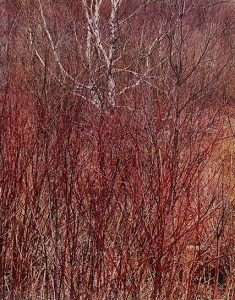
![]() The red osier, also known as the red willow, redstem dogwood, and creek dogwood, is a tall deciduous shrub found throughout northern and western North America. Eliot Porter’s Red Osier, Near Great Barrington, Massachusetts appeared in the Sierra Club book, In Wildness is the Preservation of the World, first published in 1962 to mark the centenary of the death of Henry David Thoreau.
The red osier, also known as the red willow, redstem dogwood, and creek dogwood, is a tall deciduous shrub found throughout northern and western North America. Eliot Porter’s Red Osier, Near Great Barrington, Massachusetts appeared in the Sierra Club book, In Wildness is the Preservation of the World, first published in 1962 to mark the centenary of the death of Henry David Thoreau.
Porter’s approach to illustrating Thoreau was to focus on the seasons. When published in the Sierra Club book, the red osier photograph appeared in the section devoted to spring, opposite this quotation from Thoreau’s journal that demonstra tes the writer’s meticulous observation of nature:
tes the writer’s meticulous observation of nature:
March 17, 1859
When I am opposite the end of the willow-row, seeing the osiers of perhaps two years old all in a mess, they are seen to be very distinctly yellowish beneath and scarlet above. They are fifty rods off. Here is the same chemistry that colors the leaf or fruit, coloring the bark. It is generally, perhaps always, the upper part of the twig, the more recent growth, that is the higher-colored and more flower or fruit like. So leaves are more ethereal the higher up and farther from the root. In the bark of the twigs, indeed, is the more permanent flower or fruit. The flower falls in spring or summer, the fruit and leaves fall or wither in autumn, but the blushing twigs retain their color throughout the winter and appear more brilliant than ever the succeeding spring. They are winter fruit.